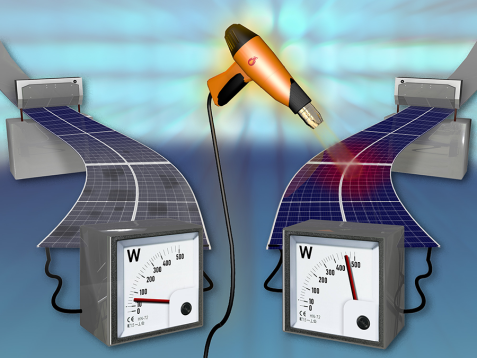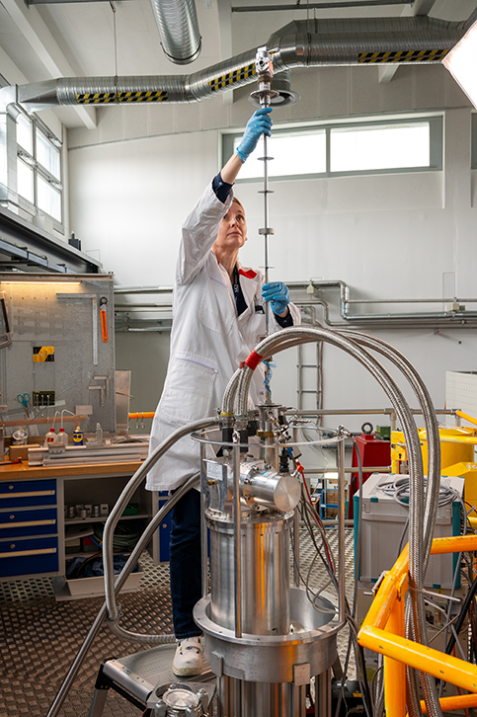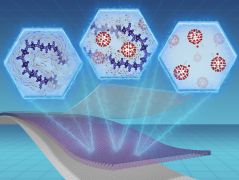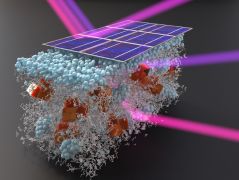MLZ is a cooperation between:
 > Technische Universität München
> Technische Universität München > Helmholtz-Zentrum Hereon
> Helmholtz-Zentrum Hereon
 > Forschungszentrum Jülich
> Forschungszentrum Jülich
MLZ is a member of:
 > LENS
> LENS > ERF-AISBL
> ERF-AISBL
MLZ on social media:

MLZ (eng)
Lichtenbergstr.1
85748 Garching
23.02.2024
Without additives: How organic solar cells are becoming more efficient
Organic photovoltaics could be mass-produced cheaply and provide renewable energy. However, the materials are chemically unstable when exposed to oxygen or intense radiation. A team of researchers has now tackled this problem and made a valuable contribution to the further development of organic photovoltaic cells.

Drying the active material of an organic photovoltaic cell increases its chemical stability and efficiency. © Reiner Müller, FRM II / TUM
Imagine a solar cell that is flexible, incredibly light, and cheap to produce. If you look at the large, heavy silicon-based cells that have become familiar on more and more roof surfaces, it sounds like science fiction.
Since the 1980s, however, researchers have been working on the next stage in developing electricity generation using solar energy, namely organic photovoltaics (OPV). Two different organic molecules serve as electron donors and acceptors.
Efficiency too low, service life too short
However, one problem remains: the efficiency of OPV cells has long been far below that of conventional solar cells.
One approach to tackling this is using solvent additives when applying the active material to the electrode. They dissolve the two types of molecules of the active material to different degrees and thus facilitate the formation of microstructures at their interfaces, where free electrons are generated and, therefore, current flows. The larger the interfaces, the more electrons, the more current. This increases efficiency.
“However, we have found that these additives can damage the cells later in use and reduce their efficiency and chemical stability,” explains Dominik Schwaiger, a physics doctoral student at the Technical University of Munich. He performed this work as part of the Chair for Functional Materials headed by Prof. Dr. Peter Müller-Buschbaum, until 2023 Scientific Director of the Heinz Maier-Leibnitz Research Neutron Source (FRM II) and at the Heinz Maier-Leibnitz Zentrum (MLZ).
Dominik Schwaiger explains: “The loss of efficiency always occurs when the cells are exposed to oxygen or light.” This significantly shortens the lifespan of the cells.

At the FRM II, Wiebke Lohstroh and her colleagues can provide researchers with various sample environments. Here, she is working on a cryostat. © Astrid Eckert, FRM II / TUM
How stable is the molecule?
So, he dried the layers after production to remove the additives. “To observe how the dried samples behave compared to the non-dried ones, we examined them using various spectroscopic experiments,” says Schwaiger.
Researchers use spectroscopy to analyze the wavelength and intensity of the light emitted or reflected by their samples. Dr. Wiebke Lohstroh, Dr. Christopher Garvey, Dr. Marcell Wolf, and Adrian Stephan from FRM II provided the thermostat of the TOFTOF neutron instrument as a sample environment for some of the experiments with laser light and provided support. “For example, we used it to investigate the absorption of light and the stability of certain molecular bonds,” says Dominik Schwaiger.
A step towards greater efficiency
So, have the results shown what needs to be considered when manufacturing OPV cells? Dominik Schwaiger says yes: “It is important to remove the additives from the material before it is used. To keep the chemical stability as high as possible, thorough drying at high temperatures and, perhaps, a vacuum are necessary.”
Current research results from other groups show that OPV cells have already achieved an efficiency of over 19% in some cases, which will soon make them just as interesting as silicon-based cells.
So perhaps this is not science fiction after all.
Original publication:
D. M. Schwaiger, W. Lohstroh, M. Wolf, C. J. Garvey, P. Müller-Buschbaum
In-situ study of degradation in PTB7:PCBM films prepared with the binary solvent additive DPE:DIO
J. Polym. Sci. 2023, 61(15), 1660.
DOI: 10.1002/pol.20230072
More information:
This work was funded by the Federal Ministry of Education and Research (BMBF) as part of project 05K16WO3 and by the German Research Foundation (DFG) as part of the Excellence Strategy of the Federal Republic of Germany-EXC 2089/1-390776260. Open Access funding made possible and organized by the DEAL project.
Contact:
Prof. Dr. Müller-Buschbaum
Department of Physics, Chair for Functional Materials
TUM School of Natural Sciences, Technical University of Munich
E-Mail: muellerb@ph.tum.de
Related News
-
25.02.2021
Windows that generate electricity
MLZ is a cooperation between:
 > Technische Universität München
> Technische Universität München > Helmholtz-Zentrum Hereon
> Helmholtz-Zentrum Hereon
 > Forschungszentrum Jülich
> Forschungszentrum Jülich
MLZ is a member of:
 > LENS
> LENS > ERF-AISBL
> ERF-AISBL
MLZ on social media:





